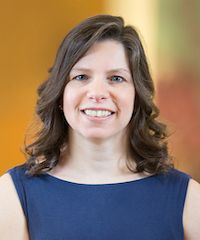Publication
Article
Urology Times Journal
AUA releases analysis of data collected from 2021 annual census
Author(s):
Amanda North, MD, discusses the AUA census in depth, specifically highlighting the data collected on residents and fellows.
“To see that we're training a more diverse group of residents makes me excited for the future of urology,” says Amanda North, MD.

The American Urological Association (AUA) recently released analyses on the data collected from the 2021 AUA annual census.1 In this interview, Amanda North, MD, chair of the AUA Data Committee, discusses the census in depth, specifically highlighting the data collected on residents and fellows. North is an associate professor of urology at Montefiore Medical Center in Bronx, New York.
Could you describe the background behind the AUA census and how it's conducted?
The AUA census is about to have its 10th anniversary next year, so 2023 will be the 10th year in a row that the AUA has done an annual census. It started back in 2014, and the idea was to collect data on practicing urologists, mostly in the United States, although—many people don't know this—there are multiple censuses that get published every year. The most widely known is the census of practicing urologists in the US. I would call that our main census.
In addition to that one, we have one on international urologists, one on residents and fellows, and one on advanced practice providers (APPs). Those are also published on the AUA website, but they're published separately, and the questions are different. Practicing urologists in the US get a different set of questions than the APPs or the residents and fellows.
There are a lot of interesting data that you can obtain from the census. The idea was to annually look at the practice of urology, and I'll talk about the one specifically in the United States. That has allowed us over the course of the past 10 years to look at trends in urology practice. Important things, like what's happening with rural urology practice? What's happening with student loan debt? What's happening with burnout? What are the trends in demographic data for practicing urologists? Are we aging out? Are we going to need more urologists in the future? We can get all of these data from the census.
It's a survey that usually gets released around the time of the annual meeting. Of course, with COVID-19, the annual meeting was a little different. Traditionally, the annual meeting has been in May. It's going to be the end of April to May 1 in 2023. That's when the census gets released. Many urologists fill out the census on a computer at the annual meeting; we have a little station set up for them to do that. We give out prizes also, so if you're interested, stop by.
Everyone gets an email with a link to the census. Some of the demographic data are autopopulated to try to reduce the number of questions people have to answer every year. The fact that my gender is female, and where I went to med school, and what my sub-specialty is, all of that will be autopopulated for me. Then there will be a variety of questions that everybody answers every year.
The census does get randomized. For example, when we put burnout on the census, the Maslach Burnout Inventory is a 22-question survey that gets embedded in the census. If we sent it to all practicing urologists, there wouldn't be any space to ask any other questions. It gets randomized to a certain percentage of urologists and then we extrapolate the data.
There's a phenomenal statistical team at the AUA, who work full time for the AUA, and they run the census. As the Data Committee chair, and previously the Workforce Work Group chair, I've worked on writing the census questions for several years now. There's a lot of urologist input into what we ask. In fact, the questions are generated by urologists, but the actual question writing, the structure of the census, and the statistics are all done by the AUA statistical team. It's a fantastic process.
The data are available to anyone who is an AUA member. You log into your AUA account, and it's right on the website. If you want to know what percentage of women were practicing urology in 2016, you can get that data at the snap of a finger. Over time, we've become more facile with how to make the census most useful, but it's been used for everything from tracking work force needs to legislative efforts in Washington, DC to support the needs of urologists and our patients. It's something I'm proud to be involved with.
What were some of the notable data regarding residents and fellows? Were any of those findings surprising to you and your fellow data committee members?
I'm glad you asked about the resident and fellow census because it just got published in the last week or two. These are brand-new data, and I encourage people to look at it because we do have some interesting data. From a demographic point of view, 1/3 of urology residents are now women. In the 2022 practicing urologists census, we're up to 11.6% women who are practicing urology. When you look at the fact that 1/3 of residents are women, we know that that feminine wave is coming to urology. For those of us who have been doing this for a while, that's exciting.
What's also interesting is that almost 1/3 of residents are non-White. There have been a lot of efforts to increase the diversity of the urologic work force, and I think the fruits of our labor are starting to show themselves when we look at the residents. Fewer than 20% of practicing urologists are non-White, so over 80% of urologists in practice are White. To see that we're training a more diverse group of residents makes me excited for the future of urology.
About 1/3 of urology residents have a child during residency. For all those program directors who are worried about pregnancy and maternity and paternity leave, it's here. We just have to plan for it and be ready for it. The American Board of Urology has done a good job of modernizing their rules to allow for maternity and paternity leave, and the census is showing that we have a need for that.
Interestingly, more than 90% of residents who had a child during residency, men and women both, felt very supported by their programs. One encouraging thing is it seems like colleagues and program directors are very supportive of people having babies during residency. I found that positive, and I didn't expect it. I thought that more people would say that they were discriminated against for having a child or they didn't feel supported. To have more than 90% of residents say they felt supported during that process is what you want to hear. I had my first child when I was a resident, so I'm very sympathetic to how difficult it can be. I love the fact that people feel supported in their decision to have a family. 75% of the residents reported that they had paid parental leave. That's great. We should be at 100%, but 75% isn't bad, and that's an improvement over the past.
The other astounding thing is the amount of educational debt. More than 50% of residents owe over $150,000 in student loan debt. One of the things that census data were used to promote is a legislative effort to offer student loan forgiveness for specialists practicing in rural areas. On the resident census, residents felt that that would be a positive way to get their student loans paid off and to encourage them to practice in more rural areas. Most residents don't anticipate practicing in a rural area, but this could help those rural communities get specialty care. I've worked on the legislative component of that, and to see that that's something residents want was, for me, very encouraging. It made me proud of the work that we've done on that.
The other big thing is burnout. Resident burnout is still high. Consistent with the last time we asked about burnout on the census, our PGY2 residents are the ones who are really suffering. They have the highest rates of burnout, and the highest rates of career regrets. We've seen that consistently every time we've asked. The message I'd give to people who work with residents is you need to support your PGY2 residents, even more than everyone else, because they're really suffering. That's a tough year. I think there are a lot of structural reasons for that. When we look at who needs the most support, second-year urology residents are the ones who need a little extra love.
Those are some of the main findings. [We also found] interesting things like residents prioritize being fed when they're on call and being able to attend doctor's appointments. I don't know why it's so hard to give a resident half a day off to be able to go to the doctor. Again, those of us in academic medicine need to make sure that our residents are able to get health care. They're not just health care providers, they're health care consumers. Especially mental health. That wasn't asked specifically, but we know residents need mental health care. Residency is a difficult time, so making sure that we make it possible for residents to get the care they need makes them better doctors and stronger people. Those are some of the things that I was excited to look at.
What are some potential applications of these data?
[There are] so many applications for the census data. One of the things we look at when we're writing census questions is what are the legislative priorities of the AUA, and what data can we collect that will support that legislative agenda? Let me give an example. There's a lot of concern that reimbursement for audio-only telehealth is going to go away. On the 2021 census, we saw that 30% of telemedicine visits were planned as audio-only. So almost 1/3 were planned as audio-only, and the health care system is no longer going to pay for that. But we can use the data from our census to go to Congress and say, 'Hey, you're making a mistake'. We need to continue to fund audio-only telemedicine because 30% of telemedicine visits are planned as audio-only, and another [41.5% of planned video visits] get converted to audio-only due to technological difficulties.
We know that for elderly patients or for patients who are in areas without broadband, they have a very difficult time doing video telemedicine visits. We're hurting the people who would benefit the most by not reimbursing audio-only. As we start to design the 2023 census, that telemedicine data are going to be important to us, because we know this is a fight that's going to be ongoing. We take that into consideration.
I already mentioned the student loan forgiveness bill that allows specialists who practice in rural areas to get student loan forgiveness. This is the bill that we're proposing. Again, it was census data looking at student loan debt and the need for rural practitioners that allowed us to go to Congress and get sponsorship for this bill. We use the census to write a couple of papers showing student loan debt is a problem for urologists, and then those papers were brought to Congress to say, 'Hey, guys, we need some help here.’ That bill hasn't been passed yet, but we're optimistic that there is bipartisan support for it based on census data. There is a huge legislative component to what we do with the census.
The other component is understanding the needs of practicing urologists and trying to address those needs. The AUA census has looked at burnout in practicing urologists twice, in 2016 and 2021. The 2021 census showed a huge increase in burnout among women urologists. COVID-19 was probably partially to blame. I don't know about other women in urology, but I was homeschooling 3 children while having a full-time job in the middle of a global pandemic. I also happen to work in the Bronx, which was the epicenter of the pandemic nationally, so it was a little stressful. My burnout rates might have gone up because of that.
[We are] understanding that we need to have more support available for all urologists, but certain demographic groups are suffering more than others. Women in urology being 1 example. That's where an organization like the Society for Women in Urology, which does all these incredible programs for women in urology, can step in and offer more mentorship programs or more support or peer-to-peer mentoring or coaching. There are different components to that. We notice that having connections helps mitigate burnout. Understanding who is at risk and then trying to find solutions is something we offer through the census.
Reference
1. The American Urological Association releases key findings on residents & fellows from the 2021 AUA census. News release. American Urological Association. November 3, 2022. Accessed November 22, 2022. https://www.prnewswire.com/news-releases/the-american-urological-association-releases-key-findings-on-residents--fellows-from-the-2021-aua-census-301667742.html




























